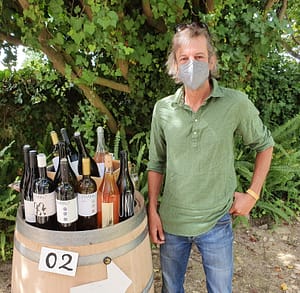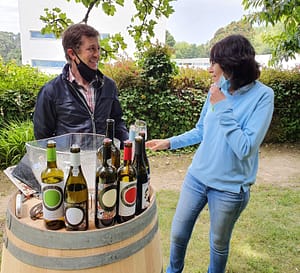In the first part from this year’s Simplesmente Vinho we highlighted some producers from outside the famous regions. (Read here.) In this long overdue second part two I would like to focus on producers from well-known wine districts that I didn’t know from before or wanted to re-taste.
From Douro, where the fair is located, I tasted several, like Quinta de Zimbro and Conceito, and also Luís Seabra, who is a little in and out of the Douro valley. Add to this one of few port wines, the lovely organic ruby from organizer João Roseira and his Quinta do Infantado, and the picture is a bit more complete, at least for me – this time.
While I missed Ana Maria Hespanol this time, her partner Hugo Mateus was there. He showed an impressive line of wines.
Traditionally Ana’s father Manuel had a good grip on the heady Douro reds. I think they have lifted the quality a couple of flats, especially with the other side of the assortment, or to bring it more in line with the times is maybe more fair to say. Anyway the whites are now often very good. Their Branco 2017, from mostly viosinho, and bottled in 2020, was harvested early to retain the acidity. Lots of primary fruits, like apples and pears. In the mouth it’s quite full, rich and long. It’s part of their often innovative, or modern, Grau Baumé line.
They have a serious orange wine, Undo Curtimenta 2020, a blend of usual Douro grapes like viosinho, rabigato, and gouveia, with 31 days of skin-contact. It’s quite textured, but yet with some feeling of lightness, aromas of white flowers, herbs and peel.
Rita and Miguel, winemakers from Conceito in the Teja Valley, showed again their impressive range, with very good prices too. Their selection falls mainly into two categories, Conceito and Contraste. Conceito is meant to be the flagship range, but I must admit that I not always understand where the dividing line is, as they both contain quality wines that sit somewhere between the classic and the modern. A wine that has not been highlighted (by me) is their Contraste Rosé, now in its 2020 vintage. It’s from higher (more than 600 meters) granite soils: Very light in colour, with raspberry and whitecurrent aromas. On the palate it’s both mellow and easy, but with a nice acidity and a serious charm. Legítimo is now in its 2018 vintage. This one is made with stems of touriga nacional, tinta roriz and touriga franca, with no sulphur. It’s dark cherry, dark fruits on the nose (blackberry) and also plums, with lactic notes (yoghurt?), and elegant tannins in the mouth. The Bastardo 2019 is, as always, superelegant, uplifting, truly inspiring. It comes from a 50 year old vineyard and ripes earlier than the others, end of august. It’s made with stems, and just a little SO2 before bottling. It’s “surprisingly” (well, not anymore) light, with a lot of raspberry and flowers, evident but light tannins.
Like many of the other producers here, to present a short report about Luís Seabra, doesn’t give him justice. He excels both in red and white, and both “xisto” and “granito” soils that are often presented on the labels. Everything is good to outstanding, from the entry-level white and red Xisto Ilimitado, via the monovarietals to the cru wines. All right, let me chose one of each. The red Xisto Ilimitado 2019 is made from a blend of touriga franca 30%, tinta roriz 20%, tinta amarela 20% and 10 each of rufete and tinta barroca. It’s clear red; aromas of fresh red berries, some balsamic and herbs; fruity and dry, with a light structure. Mono C 2019 is a castelão (that is in fact authorized in the Douro): Cherry red; red fruits (cherry), stone fruits (plum), with some herbs; lightly structured with fresh acidity. For me this wine is delicious, and ready to drink now (I have the previous vintage at home, maybe at its peak now). There are several wines with the same name. This one is from Vinho Verde: Granito Cru 2019 from alvarinho grapes is from near the river Minho in the Melgaço municipality. It’s light yellow; citric with elements of honey, lightly spicy and a touch of vanilla (after one year in barrel); good concentration in the mouth, dry, a stony minerality and great lenght. Wait two years, and it’s perfect! OK, an extra speciality for you my friend: Véu de Xisto 2015! Véu denotes that it has spent two years under flor in a barrel from Jura, France. It’s golden, but also lightly greenish; smells of yeasts, flowers, iodine; full in the mouth, rounded. By the way, the grapes are rabigato 70%, côdega do larinho 15% and the rest gouveio.
From nearby Amarante of Minho we have Quinta de Palmirinha. Fernando Paiva, biodynamic pioneer in the Vinho Verde region, never stop to impress, with both azal and arinto. But his loureiros are the stars. Really interesting from his current selection is the Leviano 2020, a “curtimento” (orange wine). Leviano denotes in Portuguese a person that doesn’t care about anything, says Fernando. But he cares about the most, from vineyard to table. Noteworthy is his use of chestnut flowers to avoid use of SO2. The Leviano spent two weeks on skins, that gives a golden hue, an aroma of ginger and white flowers. In the mouth it’s in a way gentle and mellow, but it has the unmistakable acidity from the loureiro grape.
South to Dão I had the opportunity to try the wines of Casa de Darei, that I hadn’t tasted since the opening of their “lodging” facilities (that I also used), some 20 years ago. Then José Ruivo was “chief”. Now it’s his son Carlos who is in charge. Their reds are lovely, not least the entry level Lagar de Darei 2015 from the “usual suspects” touriga nacional, tinta roriz, jaen and alfrocheiro, with its red fruit and balsamic pinewood nuances, and its luscious mouthfeel. All reds came in the 2015 vintage. New launches that “old” is quite unusual these days. I also like their rosé 2020, easy-to-drink, with its lovely raspberry character and low alcohol.
I also tried a couple of the fantastic and diverse wines of João Tavares da Pina, kindly offered by him and his wife Luisa at a lunch. Read more about one of these wines here.
Quinta do Olival da Murta is located in the Cadaval area of the Lisboa region, near the mountain range Serra de Montejunto. It’s here that Joana Vivas, who is in charge of the family business, got the inspiration for the label Serra Oca. It’s only 15 kilometers to the Atlantic ocean, which is noted in the wines, that are always made in a simple way. They have an interesting moscatel graúdo called simply Serra Oca 2019, fermented in 1000 liters oak vats, with all the lovely moscatel virtues: Golden, floral, honeyed, and with a very good acidity. More ususal local grapes, like arinto, fernão pires, were used together with the moscatel in another Serra Oca 2019 wine. This one had three days of skin-contact, partly fermented in barriques and inox. This had an interesting mix of developed and fresh aromas and taste, as if it played with oxidation; golden/brownish colour, aromatic, citric and flowery, in the mouth full with lovely acidity. If my memory doesn’t fail me it was one months before its bottling. I have not forgot their reds, that they began with in 2013 (three years before the whites), but let’s save them for a later occasion.
From down in Alentejo I found Argilla, and tasted the wines while the local student choir was singing a wide selection of songs, many of them medieaval. The winery is located at the foot of the Montargil mountains in Alto Alentejo (northwest of Évora and Estremoz). They put a lot of effort in talha wines, made in the Alentejo style of clay vessel, and also smaller amphorae. But first: I really liked their Rosa d’Argilla 2019, some kind of a clarete, made from alicante bouschet with only 20% skin-contact. It’s clear ruby; aroma of red fruits (raspberry); only slightly structured, juicy and delicious. From the Talha Argilla range I tasted 2019 white (appley, with some earthiness from the clay), and the red 2018 (red fruits and licorice, with tannins from petite verdot), both from a selection of grapes. Then came a varietal, Alfrocheiro em Talha de Argilla 2017. This was a relatively young wine, dark with a blueish hint. The flavours were very balanced; red fruits, flowers, some earthiness, – and rounded in the mouth. Rita offered more wines, that I tasted, and they were all interesting. Sorry, but this was at the very end, and I had to concentrate on the music for a while. This time it was Transmontuna, a student choir from Vila Real.
Thanks to João Roseira and the other organizers who managed to set up a magnificent fair in “times of trouble”. And the band played on…!









